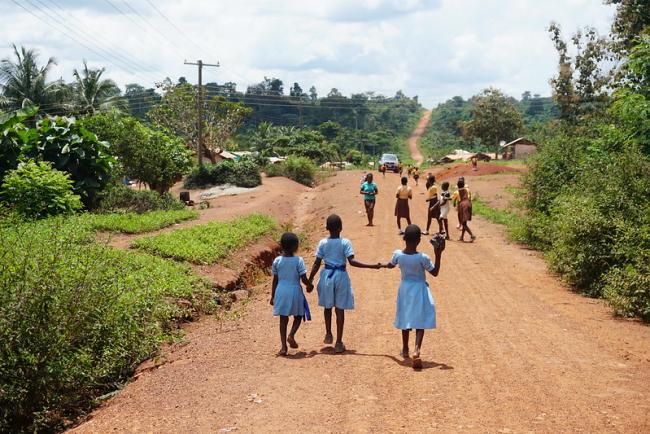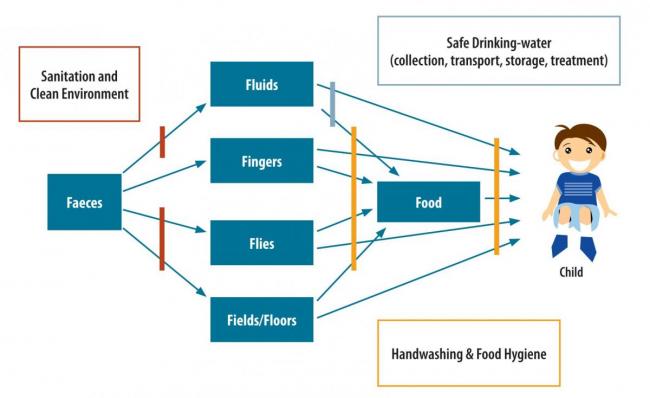A call for safely managed sanitation.
Published on: 13/11/2019

Asutufi North, Ghana. Photo: IRC
Did you know that basic Water Sanitation and Hygiene (WASH) interventions alone may not have an impact on childhood diarrhoea and stunting?
A new study (Cumming et al., 2019) reflects on three recent trials conducted in Bangladesh, Kenya and Zimbabwe that looked at the impact of WASH interventions in communities with high burden of stunting. Expectant mothers willing to participate were enrolled along with their unborn baby, and then followed for 18 to 24 months. The study assessed a variety of health outcomes, including diarrhoea prevalence and child health. In the trials, nutrition was provided at cluster level (usually 1 to 2 villages), while WASH interventions were delivered at household level. WASH interventions included increased chlorination of drinking water at point-of-use, increased access to, and use of, improved pit latrines, including safe disposal of child faeces; and increased handwashing with soap through provision of handwashing facilities and a continuous supply of soap.
With these interventions you would expect a reduction in childhood diarrhoea and stunting. However, disappointingly, results of the trials showed no effects on stunting and only mixed results on diarrhoea. Indeed, WASH interventions have shown noticeable results on diarrhoea and stunting in places where there was a significant reduction of open defecation (e.g. cases from Lao People’s Democratic Republic and Cambodia), but where the reductions are low, more intense measures are needed. In the three trials, sanitation interventions focused primarily on household interventions, and in some of the sample communities, open defecation prevailed. Thus, the study (Cumming et al, 2019) correctly highlights that low-cost basic sanitation services alone are not enough to impact diarrhoea and stunting if children are living in grossly contaminated environments where children are exposed to multiple disease transmission pathways.

Figure 1: F-diagram. WASH interventions create barriers that prevent children from faecal pathogens. Sanitation and a clean environment is the primary barrier (Source: WHO, UNICEF & USAID, 2015, p. 5)
Chlorination has long been the WASH sector’s guardian angel to deal with environmental contamination, but there are now reports of diarrhoeagenic pathogen resistance to chlorine! This implies that WASH interventions should not only aim at reducing human exposure from contaminants in the environment, but also improving environmental health.
The study by Cumming et al. does not imply that WASH should not be relied upon as a public health intervention (and indeed such interventions are critical to prevent the risk of water-borne diseases), but rather a pointer for the WASH sector that it is high time to start prioritising community-level centralised or decentralised wastewater management systems, that separate faecal matter from the environment, to supplement provision of safe drinking water. Additionally, continued behaviour change, provision of simpler and cheaper improved toilet technologies as compared to those common in high income countries, and measures taken to reduce children’s exposure to animal and human faeces in their play areas. As such, we may be oversimplifying the current sanitation challenge in developing countries: it is not just about the toilet – it is about a functioning system.
In conclusion: although it is tempting to demand a radical transformation, we need to manage expectations. As mentioned in Ian Ross’ blog responding to the results of the three trials, safely managed sanitation may not be affordable to rural households nor funders in low middle-income countries in the short and mid-term. Incremental improvements towards achieving safely managed sanitation in the long term may be a way to go, e.g. introducing modular toilets that are upgradable along the sanitation service chain. Households could start with a basic module, and as finances become available, add a module. For example, a single pit pour flush toilet can be upgraded by constructing a second, alternating pit, when the first pit is almost full. Other households may also want to add a bathing cubicle and so on.
So, as long as shit remains in the environment, we will not see the impacts on health we all so desire ...
PS: This Faecal Waste Flow Calculator is a cool (free) tool to do a quick and dirty assessment of how much faecal waste in your community or town is safely managed.
Sources:
Cumming, O., Arnold, B.F, Ban, R., Clasen, T. et al., 2019. The implications of three major new trials for the effect of water, sanitation and hygiene on childhood diarrhea and stunting: a consensus statement. BMC medicine, 17 (173), pp. 1-9, DOI: 10.1186/s12916-019-1410-x
Dillingham, R. A., Lima, A. A., & Guerrant, R. L., 2002. Cryptosporidiosis : epidemiology and impact. Microbes and infection, 4(10), pp. 1059-1066, DOI: 10.1016/S1286-4579(02)01630-1
Kov, P., Smets, S., Spears, D.E. & Vyas, S, 2013. Scaling up rural sanitation : investing in the next generation - growing tall and smart with toilets : stopping open defecation improves children's height in Cambodia. Washington, DC, USA: World Bank, Water and Sanitation Program (WSP) [More info]
Quattri, M., Smets, S. & Inthavong, V., 2014.Scaling up rural sanitation : investing in the next generation : children grow taller, and smarter, in rural villages of Lao PDR where all community members use improved sanitation. Washington, DC, USA: World Bank, Water and Sanitation Program (WSP) [More info]
WHO, UNICEF & USAID, 2015. Improving nutrition outcomes with better water, sanitation and hygiene : practical solutions for policies and programmes. Geneva, Switzerland: World Health Organization (WHO) [More info]
At IRC we have strong opinions and we value honest and frank discussion, so you won't be surprised to hear that not all the opinions on this site represent our official policy.